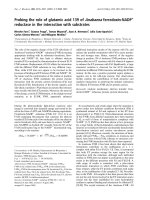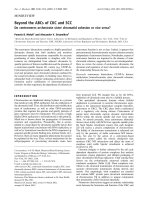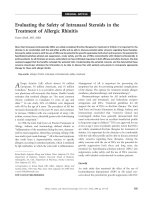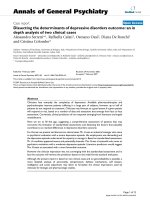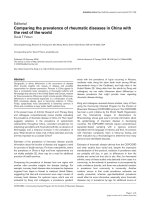Báo cáo y học: "Targeting the ubiquitin proteasome pathway for the treatment of septic shock in patients" pps
Bạn đang xem bản rút gọn của tài liệu. Xem và tải ngay bản đầy đủ của tài liệu tại đây (464.65 KB, 4 trang )
Available online />Page 1 of 4
(page number not for citation purposes)
Abstract
Endotoxic shock is a serious systemic inflammatory response to an
external biological stressor. The responsiveness of NF-κB is built
upon rapid protein modification and degradation involving the
ubiquitin proteasome pathway. Using transgenic mice, we have
obtained in vivo evidence that interference with this pathway can
alleviate the symptoms of toxic shock. We posit that administration
of proteasome inhibitors may enhance the survival of patients with
septic shock.
Multiple myeloma, endotoxic shock and
proteasome inhibitors
Multiple myeloma (MM) provides an example of the functional
importance of ubiquitin in the NF-κB pathway [1,2]. A drug
that shows great promise against MM is Velcade (bortezomib,
formerly PS-341), a specific reversible inhibitor of proteasome
function and, hence, ubiquitin-mediated proteolysis (Figure 1).
Velcade is thought to block the activation of NF-κB and
thereby deprive MM cells of the signals that are otherwise
constitutive. In cell culture and animal studies Velcade has
shown considerable activity against MM cells and is now in
phase II and III human clinical trials [3,4].
Despite available therapies, including corticosteroids, volume
replacement, antibiotics, and vasopressor support, endotoxic
shock remains a common cause of death in ICUs [5]. It is
characterized by hypotension, vascular damage, and in-
adequate tissue perfusion, often leading to the failure of many
organ systems, including liver, kidney, heart and lungs, after
systemic bacterial infection [1,5,6]. The pathogenesis of septic
shock seems to be primarily governed by lipopolysaccharide
(LPS). Significantly, NF-κB activation is a central component in
septic shock, stimulating the expression of several proinflam-
matory proteins such as TNF-α, IL-1β, IL-6, and inducible nitric
oxide synthase [1,7]. Moreover, NF-κB is stimulated by these
endogenous mediators in a paracrine and autocrine fashion. It
is conceivable, therefore, that inhibition of NF-κB activation by
a rapid acting proteasome inhibitor may be of potential
therapeutic benefit in the treatment of septic shock [8].
Viewpoint
Targeting the ubiquitin proteasome pathway for the treatment of
septic shock in patients
Jan Brun
1,2,3
and Douglas A Gray
1,2
1
Ottawa Health Research Institute, Ottawa, ON, Canada K1Y 4E9
2
Department of Biochemistry, Microbiology, and Immunology, University of Ottawa, Ottawa, ON, Canada K1H 8M5
3
Apoptosis Research Centre, Children’s Hospital of Eastern Ontario, Ottawa, ON, Canada K1H 8L1
Corresponding author: Douglas A Gray,
Published: 14 August 2009 Critical Care 2009, 13:311 (doi:10.1186/cc7946)
This article is online at />© 2009 BioMed Central Ltd
CLP = cecal ligation and puncture; IKK = IκB kinase; IL = interleukin; LPS = lipolysaccharide; MM = multiple myeloma; NF = nuclear factor; TNF =
tumor necrosis factor; TRAF = TNF-receptor-associated factor.
Figure 1
Ubiquitin proteasome pathway. An E1, E2 and E3 complex promotes
the ubiquitination of protein substrates via K48 linkage, which
predominantly targets substrates for proteasomal degradation. This
process is reversible though the action of deubiquitinating enzymes
(DUBs) that can cleave ubiquitin from the modified proteins.
Critical Care Vol 13 No 4 Brun and Gray
Page 2 of 4
(page number not for citation purposes)
Support for this assertion comes from in vivo experiments
wherein the ubiquitin proteasome system was impaired in
transgenic mice. Ubiquitin plays a role on several levels in
NF-κB activation (Figure 2) [7,9]. Upon extracellular stimu-
lation by LPS, adaptor proteins such as TNF-receptor-asso-
ciated factor 6 (TRAF6; E3 ubiquitin ligase), IL-1 receptor-
associated kinase 1 (IRAK-1) and MyD88 (Myeloid differen-
tiation primary response gene (88)) are recruited to the cyto-
plasmic domain of the receptor [10]. Subsequently, TRAF6
interacts with UBC13/UEV1A, a heterodimer that catalyzes
the synthesis of polyubiquitin chains assembled through
linkage of the carboxyl terminus of one ubiquitin molecule to
an internal lysine residue at position 63 of the subsequent
ubiquitin molecule (K63-linked chains) [11-13]. K63-linked
chains are the primary signal responsible for initiating a
kinase cascade that recruits and activates TAK1-TAB2-TAB3
and the IκB kinase (IKK) complex (IKKα, IKKβ and IKKγ) [14].
Specifically, TAK1-TAB2-TAB3 recognizes K63-linked
chains, which may facilitate the oligermerization of the
complex and promote autophosphorylation and activation of
TAK1 [14]. TAK1 then phosphorylates the IKK complex,
namely IKKβ. IKKβ proceeds to phosphorylate IκBα, an
inhibitor that sequesters NF-κB in the cytoplasm. Upon
phosphorylation, IκBα is ubiquitinated via a lysine 48 (K48)
linkage and transported to the 26S proteasome for
degradation (a process that can be disrupted by specific
proteasome inhibitors [15,16]). NF-κB then translocates to
the nucleus where it stimulates transcription of pro-
inflammatory modulators that potentiate the symptoms of
endotoxic shock.
Since K48- and K63-linked chains assemble early in the
NF-κB pathway, one could speculate that transgenic animals
expressing mutant isoforms of ubiquitin that interfere with
chain assembly in a dominant negative manner (K63R or
K48R mutant ubiquitin) would display disrupted NF-κB
activation and, thereby, survive the induction of endotoxic
shock induced by LPS. Remarkably, although all the K63R
Figure 2
NF-κB signal transduction. Extracellular stimulation of microbial ligands such as lipolysaccharide trigger the canonical NF-κB pathway that leads to
septic shock. Shortly after stimulation, a series of ubiquitination events occur that activate TAK1 and IKK complexes. This ultimately promotes IκBα
phosphorylation and its subsequent proteolysis, thereby allowing the translocation of NF-κB into the nucleus where it promotes the transcription of
its target genes. IKK = IκB kinase; JNK = c-Jun N-terminal kinase; MKK6 = Mitogen-activated protein kinase kinase 6; MyD88 = Myeloid
differentiation primary response gene (88); NF = nuclear factor; TRAF = TNF-receptor-associated factor.
and wild-type animals showed symptoms of endotoxic shock
necessitating humane euthanasia within 24 hours, more than
half the K48R animals survived for 2 weeks, at which point
the experiment was terminated (Figure 3). The more profound
effects of K48R mutant ubiquitin in vivo suggests that K48R
mutant ubiquitin interferes more strongly with NF-κB
signaling. Therefore, the proteasome is likely a better target
for anti-NF-κB intervention than the IKK cascade for
treatment of septic shock. Clinically, our findings may help
explain why Velcade has greater efficacy than the IKK
inhibitor PS-1145 in blocking the activation of NF-κB in MM
[17]. Moreover, it has become clearer that LPS triggers inflam-
matory cascades involving as many as 14 distinct signaling
pathways, including the NF-κB pathway. Interestingly, many
of the genes in these pathways are regulated by the
proteasome [18]. Therefore, combined with our results, this
may also help explain why targeting one aspect of a signaling
cascade such as IKK might not be therapeutically beneficial.
However, since the proteasome is a common regulator of
LPS signaling and proteasome inhibitors such as Velcade are
already being used in clinical trials for cancer, it is not difficult
to imagine that drugs of this type could be administered in a
bolus for the treatment of septic shock. In fact, a recent study
by Reis and colleagues [19] also supports our notion of using
proteasomal inhibition to provide protection against septic
shock. However, further studies are required to determine the
full potential of proteasomal inhibitors such as Velcade in the
treatment of septic shock.
Future: proteasome inhibition and animal
experimentation
There is much yet to be learned from in vivo systems of
septic shock and proteasome inhibition. Ideally, one would
like to survey the activity of NF-κB at the level of the whole
organism in Velcade treated and untreated animals. Opti-
mally, one would like to know how the NF-κB pathway
functions in any tissue of interest (for example, the brain or
lungs, where innate immunity is active). Preferably, this should
be done in a living animal to facilitate monitoring of temporal
changes. Conveniently, 3X NF-κB luciferase transgenic
animals (in which transcription of luciferase is dependent on
NF-κB activation) have been developed, and such reagents
could be used to validate the approach [20,21]. These
animals could be injected with various doses of bacterial LPS
to induce endotoxic shock followed by the administration of
proteasome inhibitors such as Velcade. Subsequently, they
would be injected with the substrate luciferin and imaged
using an image intensifying CCD camera. If our prediction is
correct, then there should be reduced signal in treated versus
untreated animals and a better overall survival. Moreover, this
model would also be amenable to testing the clinical
significance of proteasome inhibition in acutely infected
animals with progressive invasive infection by performing a
cecal ligation and puncture (CLP) procedure, which leads to
polymicrobial sepsis and septic shock. We believe that the
3X NF-κB luciferase CLP model would at least begin to
address possible risks associated with proteasome inhibitors
in preclinical models with an acute and invasive infection prior
to testing such therapies in patients with similar acute and
invasive infections. Interestingly, a recent study by Reis and
colleagues [19] supports the notion of enhanced survival in a
septic shock animal model with the use of proteasome
inhibition combined with antibiotic treatment. This study at
least is one of the first to demonstrate the safety of
proteasome inhibition in acutely but invasively infected
preclinical animal models. Although these results are en-
couraging, the animals were pretreated with proteasome
inhibitors and antibiotics and, thus, experiments would need
to be repeated in animals already undergoing septic shock.
Overall, we believe that these results are at least encouraging
with respect to safety and future use of proteasome inhibitors
in septic shock patients with progressive infections.
We still expect much to be learned from the in vivo 3X NF-κB
luciferase model using Velcade. Certainly, the 3X NF-κB
luciferase mouse model alone or in combination with the CLP
procedure will also be useful to test how conventional
therapies compare to proteasome inhibitors, to optimize the
pharmacological properties of such drugs for this application,
and to determine if such agents should be used indepen-
dently or in combination with current treatments.
Conclusion
Conventional therapies to treat endotoxic shock improve the
survival of some, but not all, patients; thus, additional novel
treatments are required to treat this condition. Proteasome
Available online />Page 3 of 4
(page number not for citation purposes)
Figure 3
Mutant ubiquitin expressing mice are protected from endotoxic shock.
Survival of FVB/N transgenic mice expressing wild-type (WT) and
mutant ubiquitin (K48R or K63R) after a toxic intraperitoneal dose of
40 mg/kg of lipopolysaccharide. Two independent lines of K63R mice
were evaluated (lines 75 and 204). The generation of these lines has
been described in previous publications [22,23].
inhibitors effectively target the main signaling pathway(s)
active during septic shock, and genetic experiments suggest
that inhibition of this system should be advantageous for
clinical interventions. It would seem desirable, therefore, to
evaluate the potential of existing or novel proteasome
inhibitors to promote the survival of patients experiencing
toxic shock.
Competing interests
The authors declare that they have no competing interests.
Acknowledgements
We thank Dr R Chiu (University of Maastricht) for contributing Figure 2
of this manuscript.
References
1. Cohen J: The immunopathogenesis of sepsis. Nature 2002,
420:885-891.
2. Mitsiades N, Mitsiades CS, Poulaki V, Chauhan D, Fanourakis G,
Gu X, Bailey C, Joseph M, Libermann TA, Treon SP, Munshi NC,
Richardson PG, Hideshima T, Anderson KC: Molecular sequelae
of proteasome inhibition in human multiple myeloma cells.
Proc Natl Acad Sci USA 2002, 99:14374-14379.
3. Jagannath S, Barlogie B, Berenson J, Siegel D, Irwin D, Richard-
son PG, Niesvizky R, Alexanian R, Limentani SA, Alsina M, Adams
J, Kauffman M, Esseltine DL, Schenkein DP, Anderson KC: A
phase 2 study of two doses of bortezomib in relapsed or
refractory myeloma. Br J Haematol 2004, 127:165-172.
4. Orlowski RZ, Nagler A, Sonneveld P, Bladé J, Hajek R, Spencer
A, San Miguel J, Robak T, Dmoszynska A, Horvath N, Spicka I,
Sutherland HJ, Suvorov AN, Zhuang SH, Parekh T, Xiu L, Yuan Z,
Rackoff W, Harousseau JL: Randomized phase III study of
pegylated liposomal doxorubicin plus bortezomib compared
with bortezomib alone in relapsed or refractory multiple
myeloma: combination therapy improves time to progression.
J Clin Oncol 2007, 25:3892-3901.
5. Parrillo JE: Pathogenetic mechanisms of septic shock. N Engl J
Med 1993, 328:1471-1477.
6. Danner RL, Elin RJ, Hosseini JM, Wesley RA, Reilly JM, Parillo JE:
Endotoxemia in human septic shock. Chest 1991, 99:169-175.
7. Li Q, Verma IM: NF-kappaB regulation in the immune system.
Nat Rev Immunol 2002, 2:725-734.
8. Wullaert A, Heyninck K, Janssens S, Beyaert R: Ubiquitin: tool
and target for intracellular NF-kappaB inhibitors. Trends
Immunol 2006, 27:533-540.
9. Chen ZJ: Ubiquitin signalling in the NF-kappaB pathway.
Nature Cell Biol 2005, 7:758-765.
10. Courtois G, Israel A: NF-kappa B defects in humans: the
NEMO/incontinentia pigmenti connection. Sci STKE 2000,
2000:PE1.11752619
11. Deng L, Wang C, Spencer E, Yang L, Braun A, You J, Slaughter
C, Pickart C, Chen ZJ: Activation of the IkappaB kinase
complex by TRAF6 requires a dimeric ubiquitin-conjugating
enzyme complex and a unique polyubiquitin chain. Cell 2000,
103:351-361.
12. Lomaga MA, Yeh WC, Sarosi I, Duncan GS, Furlonger C, Ho A,
Morony S, Capparelli C, Van G, Kaufman S, van der Heiden A, Itie
A, Wakeham A, Khoo W, Sasaki T, Cao Z, Penninger JM, Paige
CJ, Lacey DL, Dunstan CR, Boyle WJ, Goeddel DV, Mak TW:
TRAF6 deficiency results in osteopetrosis and defective inter-
leukin-1, CD40, and LPS signaling. Genes Dev 1999, 13:1015-
1024.
13. Wang C, Deng L, Hong M, Akkaraju GR, Inoue J, Chen ZJ: TAK1
is a ubiquitin-dependent kinase of MKK and IKK. Nature 2001,
412:346-351.
14. Kanayama A, Seth RB, Sun L, Ea CK, Hong M, Shaito A, Chiu YH,
Deng L, Chen ZJ: TAB2 and TAB3 activate the NF-kappaB
pathway through binding to polyubiquitin chains. Mol Cell
2004, 15:535-548.
15. Chen Z, Hagler J, Palombella VJ, Melandri F, Scherer D, Ballard D,
Maniatis T: Signal-induced site-specific phosphorylation
targets I kappa B alpha to the ubiquitin-proteasome pathway.
Genes Dev 1995, 9:1586-1597.
16. Scherer DC, Brockman JA, Chen Z, Maniatis T, Ballard DW:
Signal-induced degradation of I kappa B alpha requires site-
specific ubiquitination. Proc Natl Acad Sci USA 1995, 92:
11259-11263.
17. Hideshima T, Chauhan D, Richardson P, Mitsiades C, Mitsiades
N, Hayashi T, Munshi N, Dang L, Castro A, Palombella V, Adams
J, Anderson KC: NF-kappa B as a therapeutic target in multiple
myeloma. J Biol Chem 2002, 277:16639-16647.
18. Shen J, Reis J, Morrison DC, Papasian C, Raghavakaimal S,
Kolbert C, Qureshi AA, Vogel SN, Qureshi N: Key inflammatory
signaling pathways are regulated by the proteasome. Shock
2006, 25:472-484.
19. Reis J, Tan X, Yang R, Rockwell CE, Papasian CJ, Vogel SN, Mor-
rison DC, Qureshi AA, Qureshi N: A combination of proteasome
inhibitors and antibiotics prevents lethality in a septic shock
model. Innate Immun 2008, 14:319-329.
20. Alexander G, Carlsen H, Blomhoff R: Strong in vivo activation of
NF-kappaB in mouse lenses by classic stressors. Invest Oph-
thalmol Vis Sci 2003, 44:2683-2688.
21. Carlsen H, Moskaug JO, Fromm SH, Blomhoff R: In vivo imaging
of NF-kappa B activity. J Immunol 2002, 168:1441-1446.
22. Tsirigotis M, Tang MY, Beyers M, Zhang M, Woulfe J, Gray DA:
Delayed spinocerebellar ataxia in transgenic mice expressing
mutant ubiquitin. Neuropathol Appl Neurobiol 2006, 32:26-39.
23. Tsirigotis M, Thurig S, Dube M, Vanderhyden BC, Zhang M, Gray
DA: Analysis of ubiquitination in vivo using a transgenic
mouse model. Biotechniques 2001, 31:120-126, 128, 130.
Critical Care Vol 13 No 4 Brun and Gray
Page 4 of 4
(page number not for citation purposes)


